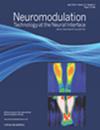Burst Stimulation Evokes Increased Bladder and Urethral Pressure in Patients With Sacral Neuromodulation, Indicating Potential Activation of the Autonomic Nervous System: A Pilot Study
IF 3.2
3区 医学
Q2 CLINICAL NEUROLOGY
引用次数: 0
Abstract
Objectives
Currently, sacral neuromodulation (SNM) outcomes are often suboptimal, and changing stimulation parameters might improve SNM efficacy. Burst stimulation mimics physiological burst firing of the nervous system and might therefore benefit patients treated with SNM. The purpose of the present pilot study was to evaluate the effect of various Burst SNM paradigms on bladder and urethral pressure in patients with overactive bladder (OAB) or nonobstructive urinary retention (NOUR).
Materials and Methods
The bladder was filled to 50% of its capacity under general anesthesia in six patients with an implanted sacral lead for SNM purposes. Bladder pressure, and mid- and proximal urethral pressure were measured using conventional (Con-) SNM and various Burst SNM paradigms (10-20-40 Hz interburst frequency) with increasing amplitudes up to 5 mA for Con-SNM and 4 mA for Burst SNM.
Results
Burst SNM caused a substantial increase in both bladder and urethral pressure. In contrast, Con-SNM caused a milder increase in urethral pressure, and only one patient showed a modest increase in bladder pressure. Furthermore, the pressure increase was higher in the proximal urethra than in the midurethra using Burst-SNM, whereas Con-SNM caused comparable increases in proximal and midurethra pressure.
Conclusions
Burst SNM induces bladder contraction compared with Con-SNM and induces higher pressure increases in bladder and proximal urethra than does Con-SNM in patients with OAB or NOUR, indicating a higher degree of autonomic nervous system stimulation. The observed responses could not be fully explained by the total charge of the Burst SNM paradigms, which suggests the importance of individual Burst SNM parameters, such as frequency and amplitude. Future studies should assess the feasibility and efficacy of Burst SNM in awake patients.
骶神经调节患者的迸发刺激引起膀胱和尿道压力增加,表明自主神经系统可能被激活:一项试点研究。
目的:目前,骶神经调控(SNM)的疗效往往不尽如人意,改变刺激参数可能会提高骶神经调控的疗效。猝发刺激可模仿神经系统的生理性猝发,因此可能有益于接受骶神经调控治疗的患者。本试验性研究的目的是评估各种爆发式 SNM 范式对膀胱过度活动症(OAB)或非梗阻性尿潴留(NOUR)患者的膀胱和尿道压力的影响:在全身麻醉的情况下,将六名患者的膀胱充盈至其容量的 50%,并植入用于 SNM 的骶管导联。使用传统(Con-)SNM 和各种爆发式 SNM 范例(爆发间频率为 10-20-40 Hz)测量膀胱压力、中段和近端尿道压力,Con-SNM 的振幅增加到 5 mA,爆发式 SNM 的振幅增加到 4 mA:结果:爆破式 SNM 会导致膀胱和尿道压力大幅增加。相比之下,Con-SNM 引起的尿道压力增加较轻,只有一名患者的膀胱压力略有增加。此外,使用 Burst-SNM 时,尿道近端压力的增加高于尿道中段压力的增加,而 Con-SNM 则导致尿道近端和尿道中段压力的增加相当:结论:在 OAB 或 NOUR 患者中,与 Con-SNM 相比,Burst SNM 可诱导膀胱收缩,并且与 Con-SNM 相比,Burst SNM 可诱导膀胱和近端尿道压力升高,这表明自律神经系统受到的刺激程度更高。所观察到的反应并不能完全用爆破式SNM范式的总电荷来解释,这表明频率和振幅等单个爆破式SNM参数的重要性。未来的研究应评估爆破式核磁共振成像技术在清醒患者中的可行性和有效性。
本文章由计算机程序翻译,如有差异,请以英文原文为准。
求助全文
约1分钟内获得全文
求助全文
来源期刊

Neuromodulation
医学-临床神经学
CiteScore
6.40
自引率
3.60%
发文量
978
审稿时长
54 days
期刊介绍:
Neuromodulation: Technology at the Neural Interface is the preeminent journal in the area of neuromodulation, providing our readership with the state of the art clinical, translational, and basic science research in the field. For clinicians, engineers, scientists and members of the biotechnology industry alike, Neuromodulation provides timely and rigorously peer-reviewed articles on the technology, science, and clinical application of devices that interface with the nervous system to treat disease and improve function.
 求助内容:
求助内容: 应助结果提醒方式:
应助结果提醒方式:


